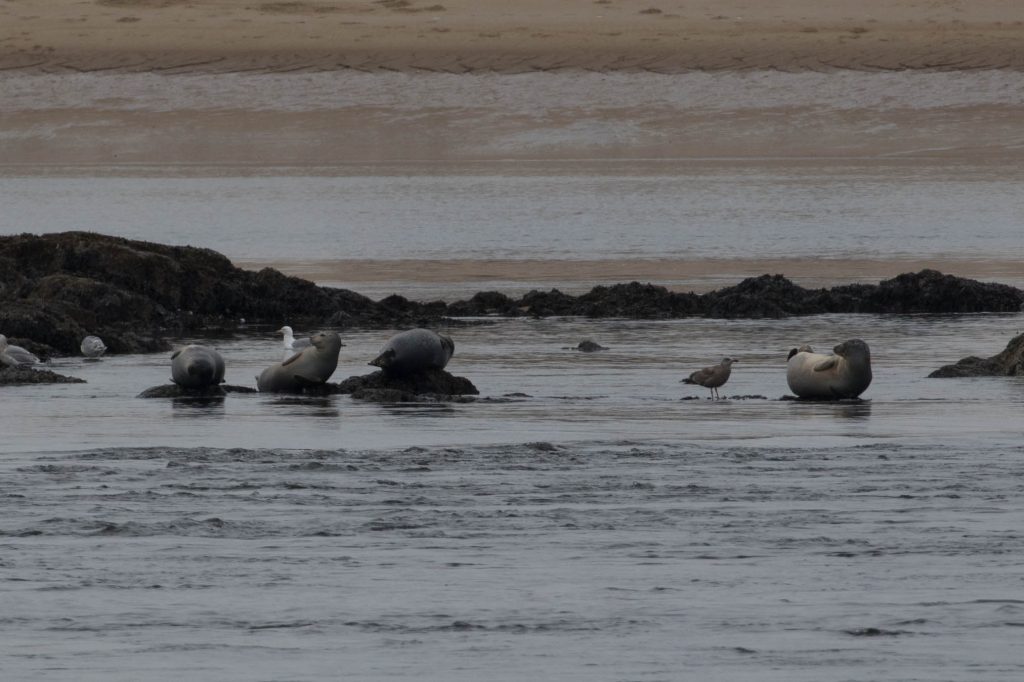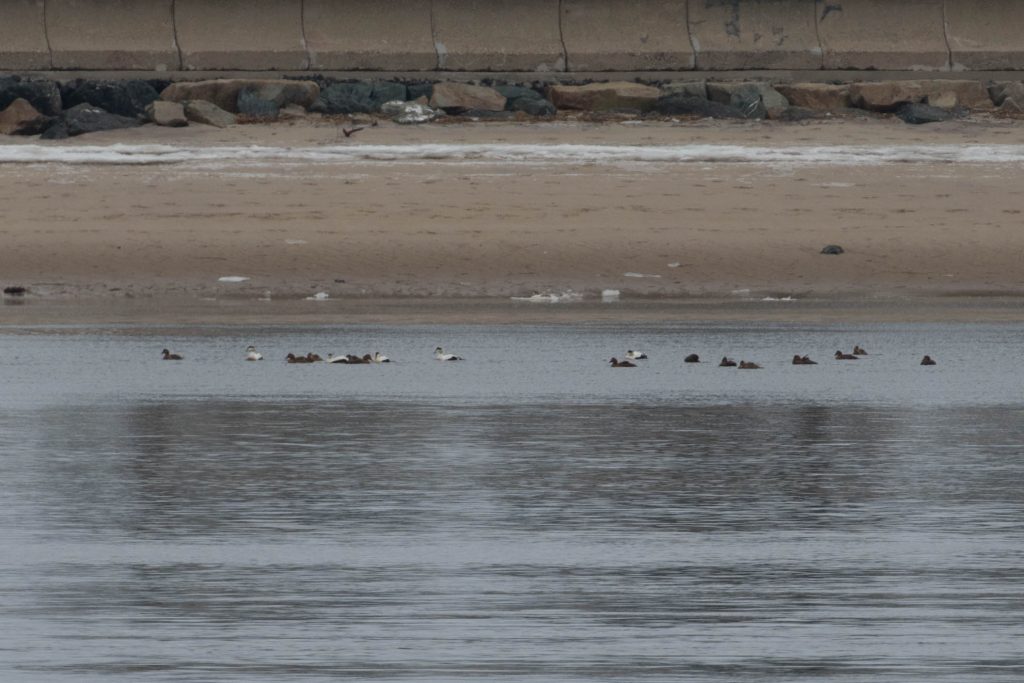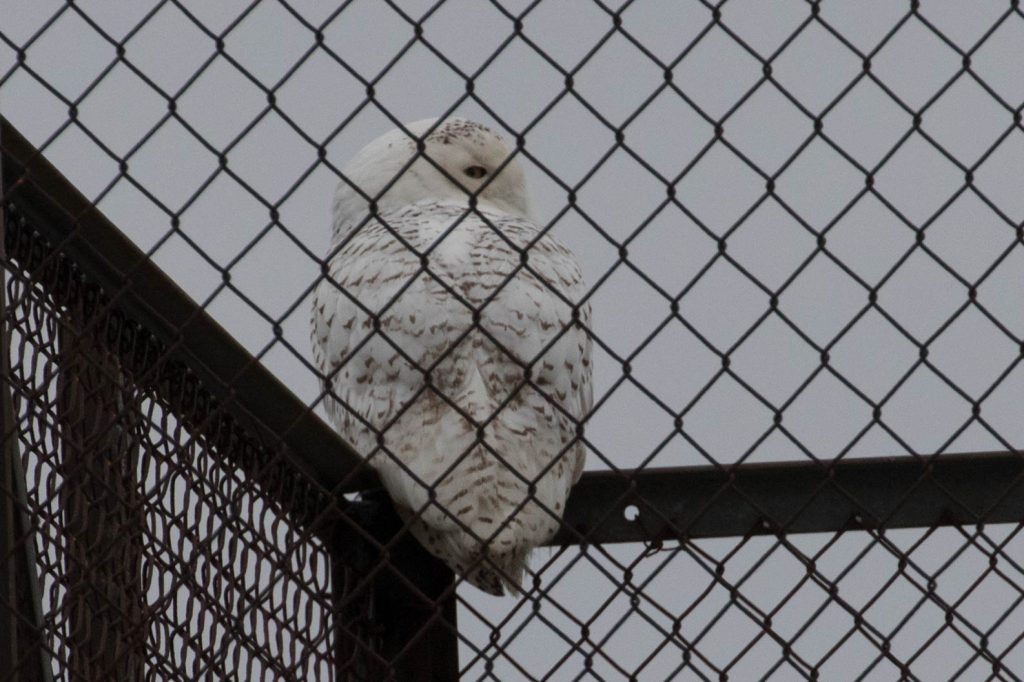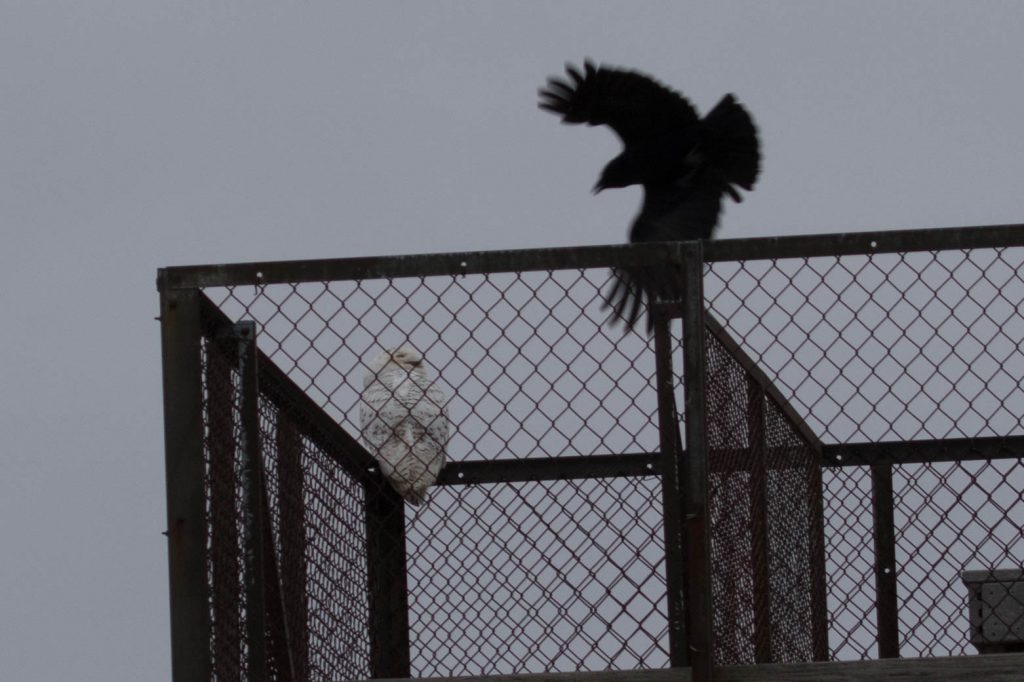Rarely have we tried as hard as we did this week to dissuade people from coming to WMB without actually cancelling it. Seven determined people joined Susan Yurkus and me to see what we could do before the storm hit, including one fellow who wandered into the center to ask about hiking trails. He left a new birder! We began at the North End of Plum Island, where the bird count was much higher than in recent weeks. As often happens in winter, walking to the sandy riverbank was to walk right up close to a drake Common Goldeneye. He and a few others were foraging nearby, and we could see that there were more all over the wider parts of the Merrimack River upstream from us. It took them a while to arrive this year, but there they are, all set for Eagle Festival next weekend. At one point we had good views of a pair of drakes displaying. Also recently arrived in good numbers were many Long-tailed Ducks. They will put on a show, flying fast up and down the river at the mouth, until it’s time to go back north.

Harbor Seals and gulls on the rocks at Salisbury – David Moon
Common Eiders and White-winged Scoters were also in good supply around the river mouth. What was missing were loons. Not one loon, either common or red-throated could we find there, where we often count them into the teens. Red-breasted Mergansers put in a good showing in the river and at all our ocean sites for the day.

Common Eiders resting at Salisbury – David Moon
Not much showed in the neighborhoods of the North End this week, only Rock Pigeons that hunkered on rooftops, looking like they knew it was going to get ugly out. Arriving at parking lot #1 in the Parker River National Wildlife Refuge, however, it was a different story. We parked near the marsh to get a look at a flock of American Tree Sparrows. They really like the edges of the refuge road. Then a big dark bird landed on the marsh out beyond the Plum Island River, looking larger than the geese, and making us think “eagle.” But the small bill on the bird quickly told us that we had a very dark morph Rough-legged Hawk. It gave us fleeting looks at the bold underwing pattern before disappearing down the marsh.

Snowy Owl on Hellcat observation tower – David Moon
Up on the ocean view platform, we found an empty-looking sea. This time it stayed that way, with only scattered White-winged Scoters, a few eiders, and nothing showing up inland. The clouds looked dark to the west and south. On our way out, we heard from some helpful birders of a Snowy Owl at Hellcat. The marsh, thickets, and pannes were empty the entire way to parking lot #4. No birds moved in the thickets there. Nothing appeared anywhere as we walked onto the dike, until John Cannizzo spotted a Snowy Owl way down south of us on the Osprey platform on the tripod in the south marsh. Meanwhile, we at first missed the very nearby Snowy Owl on the railing of the observation tower! Two crows set up a ruckus from the tree next to the tower, then began making showy but ineffective runs at the owl. While it is unlikely that the owl actually yawned at the crows, it certainly didn’t move a wing or even sit up straighter.

Snowy Owl harassed by a crow – David Moon
Feeling rather happy to see such an entertaining show, we headed for Emerson Rocks. It was low tide, and just glancing around we could see interesting birds on the water. A Horned Grebe foraged in the cove formed by the rocks, while three more of them dove in synchrony out beyond the edge of the pile. Eiders were scattered about with several Common Loons. Three Brants flew off from behind the rocks, birds we hope to see more of soon at Joppa. A fairly tight raft of Black Scoters hung by the end of the rocks that descend from Bar Head. They are displaying and singing at this time of year, but to hear it you have to have extremely calm conditions.
At this point, the few flakes flying around that we dismissed at Hellcat grew to the point that meant it was time to go, so we scurried home. Just as we were leaving the refuge, however, a Cooper’s Hawk flew after a bunch of starlings and then landed on a power line over the middle of the road. Perhaps the handsome bird was able to get its fill before the storm really landed.
Next week, we will meet at Cape Ann to enjoy all the delights of Gloucester and Rockport, and especially to try for the alcids that have been seen lately. Join us!
Our list:
Brant (3) – seven ocean
Canada Goose – common.
American Black Duck – common.
Mallard – several.
Common Eider – (50-60); ~ 45, North End; 15 seven ocean.
White-winged Scoter – common.
Black Scoter (12) – seven ocean.
Long-tailed Duck – common.
Bufflehead (~ 15) – seven ocean.
Common Goldeneye – (35+) 25+, North End; 10, seven ocean.
Red-breasted Merganser – (10) Scattered over North End, ocean sites.
Common Loon (7) – 0, North End; 1, one ocean; 6, seven ocean.
Horned Grebe (4) – seven ocean.
Cooper’s Hawk (1) – refuge entrance road.
Rough-legged Hawk (1) – dark morph, North Marsh.
Ring-billed Gull
Herring Gull
Great Black-backed Gull
Rock Pigeon
Snowy Owl (2) – 1, South Marsh tripod; 1, Hellcat observation tower.
American Crow (2) – harassing SNOW at Hellcat.
Northern Mockingbird (1) – South Marsh edge.
European Starling
American Tree Sparrow (14) – 3 flocks along edge of refuge road, lot one – south marsh.
Song Sparrow (2) – S-curves.
Dark-eyed Junco (5) – various

